MILKWEED
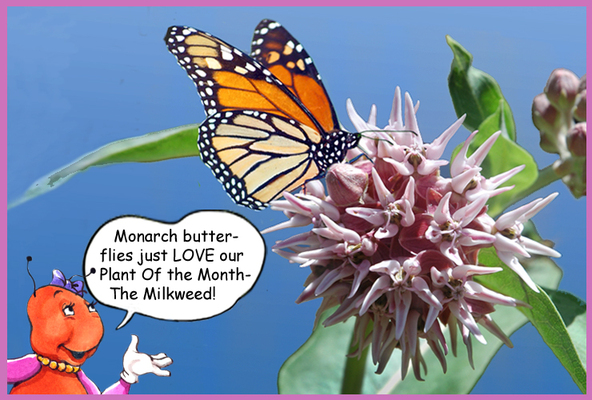
Milkweed grows all over The United States except for the dry areas of prairies and deserts. There are several different types.
Our Plant Of the Month is called "Common Milkweed".
The Common Milkweed can grow to be 3 to 6 feet tall. It has only one thick stalk that branches out at the top with stems for flower heads.
The main stalk is tough and strong,
and twine or string can be made from it. Mostly this plant is known as food for the beautiful Monarch Butterfly and their little caterpillars, but our Plant Of the Month has much more to offer.
Our Plant Of the Month is called "Common Milkweed".
The Common Milkweed can grow to be 3 to 6 feet tall. It has only one thick stalk that branches out at the top with stems for flower heads.
The main stalk is tough and strong,
and twine or string can be made from it. Mostly this plant is known as food for the beautiful Monarch Butterfly and their little caterpillars, but our Plant Of the Month has much more to offer.
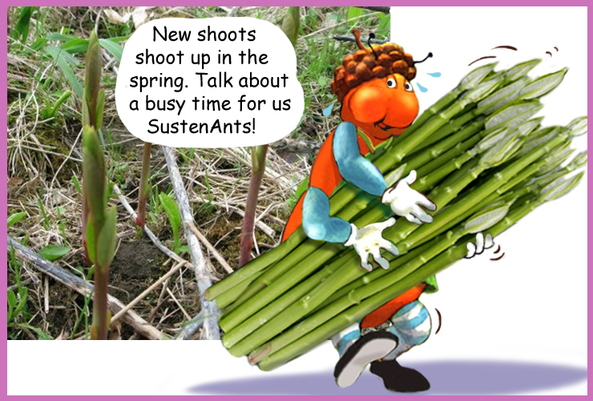
In late spring the new shoots push up among last season's dry stalks.
These shoots are edible. But be careful! There is a look-alike called Dogbane, that is poisonous! The Dogbane shoots are much thinner and both the stems and the leaves are smooth. They're reddish purple on the upper part of the stem.
The stem and leaves of the Common Milkweed are a tiny bit fuzzy.
Remember - never pop anything in your mouth that grows wild outdoors, unless you are totally sure or you're with an adult who knows what's edible!
These shoots are edible. But be careful! There is a look-alike called Dogbane, that is poisonous! The Dogbane shoots are much thinner and both the stems and the leaves are smooth. They're reddish purple on the upper part of the stem.
The stem and leaves of the Common Milkweed are a tiny bit fuzzy.
Remember - never pop anything in your mouth that grows wild outdoors, unless you are totally sure or you're with an adult who knows what's edible!
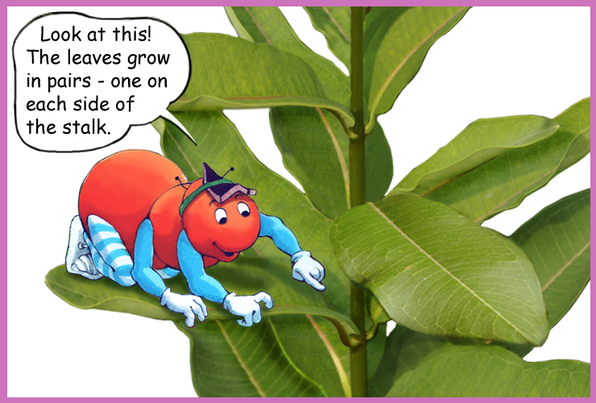
The leaves of the Common Milkweed are large and oval. They have even edges and are smooth on top and a bit fuzzy underneath.
If you tear a leaf you'll see a white liquid inside. As a matter of fact, the whole plant is full of this sticky, milky stuff that will ooze out if any part is cut or torn.
That, naturally, is how it got its name - Milkweed.
Each new pair of leaves appear several inches above the last and are rotated so they sit between the pair below. You can check it out on the picture to the left.
If you tear a leaf you'll see a white liquid inside. As a matter of fact, the whole plant is full of this sticky, milky stuff that will ooze out if any part is cut or torn.
That, naturally, is how it got its name - Milkweed.
Each new pair of leaves appear several inches above the last and are rotated so they sit between the pair below. You can check it out on the picture to the left.
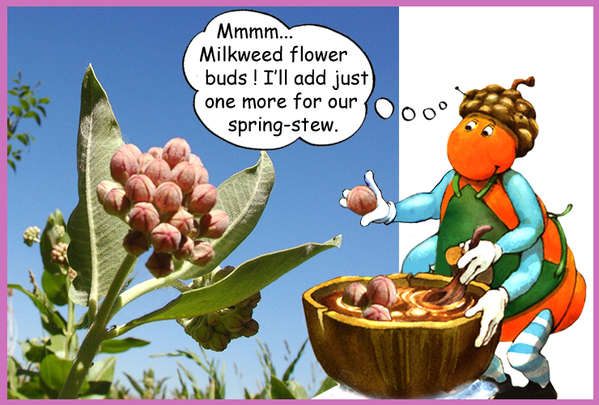
The flower buds grow in clusters.
They first appear in early summer and are first a light green color. They look like little heads of broccoli.
The ones you see here have already turned light pink.
The Common Milkweed buds can be eaten, too, but in small amounts.
They taste like the young shoots and are great in a stir-fry, soup or stew.
The SustenAnt here is making sure he gets just the right amount for his stew.
They first appear in early summer and are first a light green color. They look like little heads of broccoli.
The ones you see here have already turned light pink.
The Common Milkweed buds can be eaten, too, but in small amounts.
They taste like the young shoots and are great in a stir-fry, soup or stew.
The SustenAnt here is making sure he gets just the right amount for his stew.
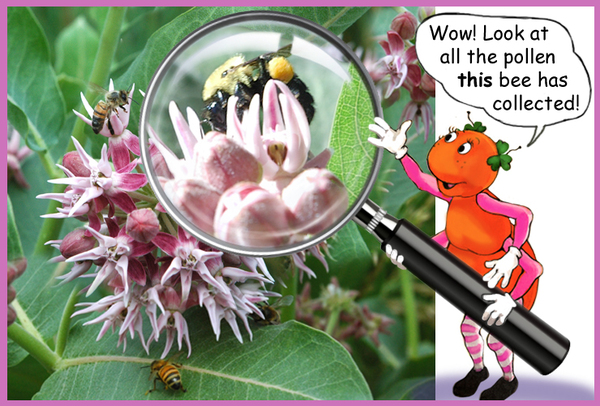
The flowers can be light pink to reddish purple.
They have a strong, sweet smell. When in full bloom these flower heads are like spiky balls of beautiful pink blossoms.
Besides being the Monarch butterfly's favorite, they are also pretty popular with hummingbirds and bees.
Only one to five flowers of each head become fertilized and produce seeds.
They have a strong, sweet smell. When in full bloom these flower heads are like spiky balls of beautiful pink blossoms.
Besides being the Monarch butterfly's favorite, they are also pretty popular with hummingbirds and bees.
Only one to five flowers of each head become fertilized and produce seeds.
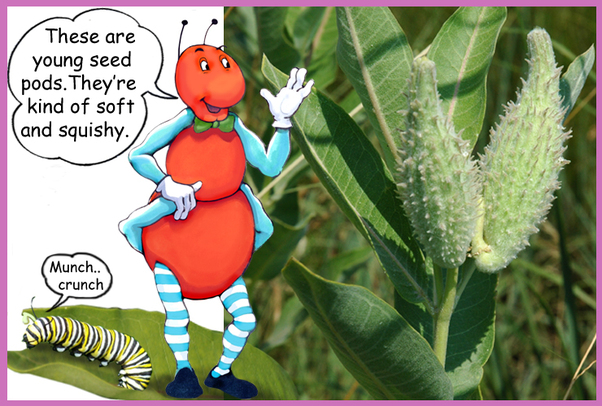
In the late summer and early fall, when the flower heads have dried up, new seed pods appear in their place.
They start out as soft, green, bumpy things which can grow to be about four - five inches long.
They also have the white, milky stuff inside.
As the seeds grow and get ready inside, the shell of the pods turn light brown and harden.
And the white liquid dries up.
They start out as soft, green, bumpy things which can grow to be about four - five inches long.
They also have the white, milky stuff inside.
As the seeds grow and get ready inside, the shell of the pods turn light brown and harden.
And the white liquid dries up.

The pod splits open lengthwise when the seeds are mature.
Inside they have formed this perfect shape of layered scales. Then the air dries the silky fluff and it seems like the whole pod explodes in a mass of seeds and fuzz.
This fluffy, fuzzy stuff has lots of uses. It can be used as filling for life vests. It can be stuffing for mattresses and more.
Inside they have formed this perfect shape of layered scales. Then the air dries the silky fluff and it seems like the whole pod explodes in a mass of seeds and fuzz.
This fluffy, fuzzy stuff has lots of uses. It can be used as filling for life vests. It can be stuffing for mattresses and more.
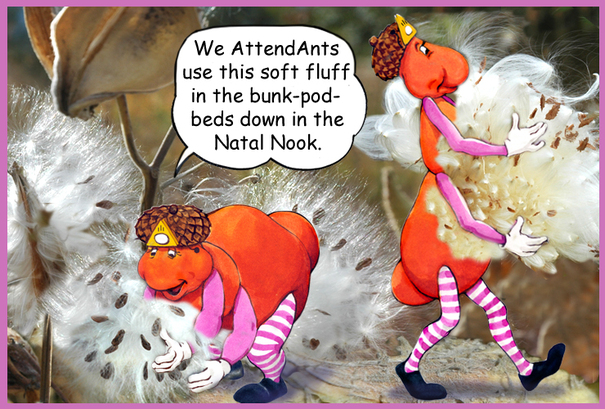
This time of the year the AttendAnts really get busy.
Here you see Nessa and Foll gathering huge hab-fuls of the stuff.
They collect and use the milkweed-fluff to help keep the little Infs warm and cozy in their bunk-pod-beds.
The ServAnts get busy, too.
They stuff pillows and comforters for everyone in the village. All of Ganterville is getting ready for the cold winter months.
Click on the Ova Nova Day slide show for more info about the first chapter of a gallavants life.
Here you see Nessa and Foll gathering huge hab-fuls of the stuff.
They collect and use the milkweed-fluff to help keep the little Infs warm and cozy in their bunk-pod-beds.
The ServAnts get busy, too.
They stuff pillows and comforters for everyone in the village. All of Ganterville is getting ready for the cold winter months.
Click on the Ova Nova Day slide show for more info about the first chapter of a gallavants life.
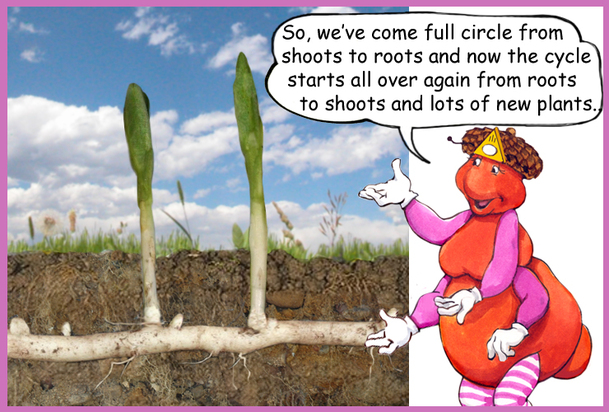
Connecting plants to the soil are, of course, the roots.
The roots of the Common Milkweed are long and sturdy. They grow sideways - just deep enough for a farmer's plow to miss them. Farmers are not too happy with these plants since they can be a bit invasive. (They're not called a "weed" for nothing.)
New shoots can pop up here and there along the main roots.
There can be a whole new colony of Common Milkweed from just one happy plant.
The roots of the Common Milkweed are long and sturdy. They grow sideways - just deep enough for a farmer's plow to miss them. Farmers are not too happy with these plants since they can be a bit invasive. (They're not called a "weed" for nothing.)
New shoots can pop up here and there along the main roots.
There can be a whole new colony of Common Milkweed from just one happy plant.
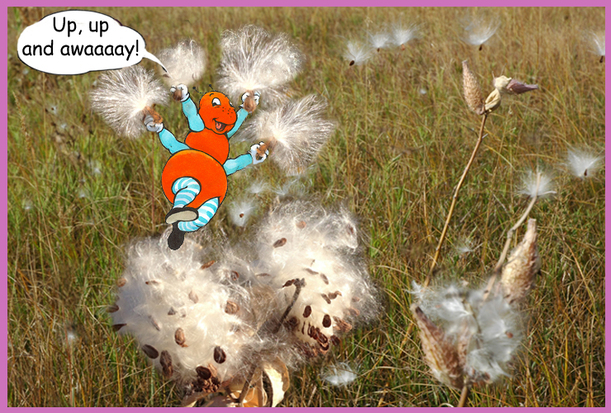
When it comes to weeds, Mother Nature has several ways of making sure they can spread and multiply.
Besides new shoots springing up from the roots, there are, of course, lots of seeds ready to fly.
Each seed has its own little fluff-parachute and thanks to the wind they can travel far away before settling down into the brown earth. They'll sleep right through the winter. When spring comes they germinate and, if no-one picks the shoots for stir-fry, they can grow up to be new, tall, beautiful Common Milkweeds.
Besides new shoots springing up from the roots, there are, of course, lots of seeds ready to fly.
Each seed has its own little fluff-parachute and thanks to the wind they can travel far away before settling down into the brown earth. They'll sleep right through the winter. When spring comes they germinate and, if no-one picks the shoots for stir-fry, they can grow up to be new, tall, beautiful Common Milkweeds.